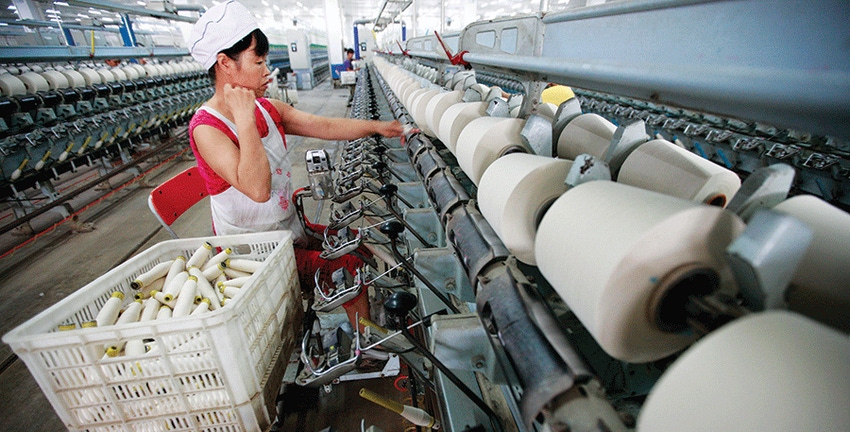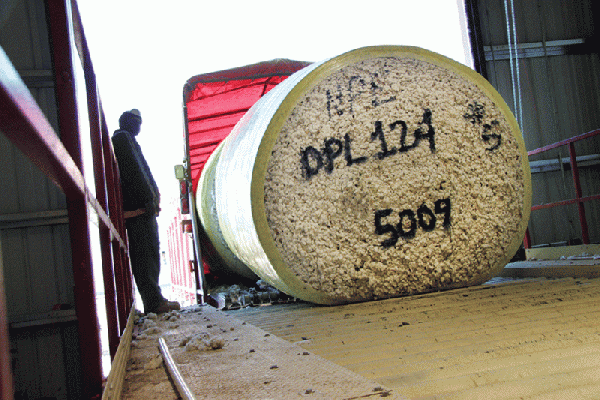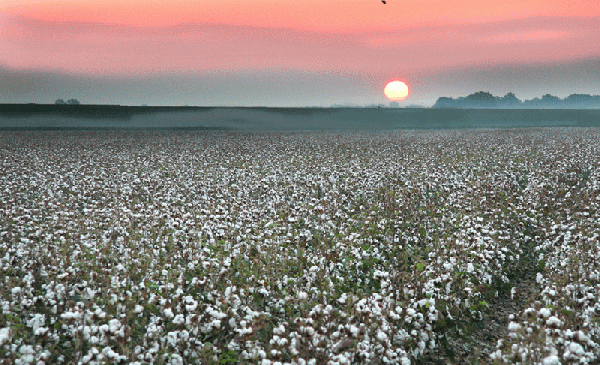

BILL GILLON
Cotton is at war, says Bill Gillon, and “the enemy is not African cotton, or Chinese cotton, or Indian cotton — we’re at war with synthetic fabrics. And if we win this fight, or at least do better than we’ve been doing in recent years, we’ll boost consumption and demand for U.S. growers’ premium cotton.”
The “disruptive policies” in China have put cotton at “a severe competitive disadvantage” to synthetics within China, the No. 1 textile producing country in the world, says Gillon, who is president and CEO of The Cotton Board, which collects assessments from U.S. cotton growers for the research and promotion programs of Cotton Incorporated.
“The huge buildup of cotton stocks in China has been a major influence on cotton price,” he said at the joint annual meeting of the Mississippi Boll Weevil Management Corporation and the Mississippi Farm Bureau Federation Cotton Policy Committee. “But the price disparity between polyester and cotton within China has caused a major increase in the use of polyester by their mills, and that has hammered U.S. cotton’s market share. We have to fight back more effectively.”
Check Current Cotton Futures Prices
But, because of the sharp drop in U.S. cotton acres in recent years, revenue from assessments has also declined, which means, Gillon says, the battle will have to be waged with smaller budgets.

The U.S. is the world's largest consumer market for fiber, but cotton's share has declined in recent years.
The Cotton Incorporated research and promotion budget hit a high point of $83 million three years ago, he says, and has been declining since. “Our budget this year is $76 million, and we’re in the process of approving a 2017 budget of $70 million. We’re hoping that will be the floor, and that we can build back up as we become more successful. But it’s going to be necessary that we do a better job of prioritizing. We can’t do the same things we’ve been doing with less money — we have to be more effective and efficient. “
Going into 2017, Gillon says, “There will be significant changes in the way we do business. We have to be more targeted, more precise, and we have to better define what our targets are. Cotton Incorporated is stressing the importance of cross-divisional cooperation within its organization, and we want to do a better job of leveraging resources with other organizations, such as the National Cotton Council and Cotton Council International.
Global cotton demand needs to expand
“We’ve already seen trimming at the edges as each of these organizations looks at everything they’re doing, trying to eliminate redundancies, figure out what’s being copied from someone else and letting that go, and expanding our core efforts as we get more efficient. In the process, I think we’ll all broaden the impact we have worldwide.”

“Among Cotton Incorporated goals is a more aggressive marketing strategy vis-à-vis synthetics.
Global cotton demand needs to expand at a faster rate than it has in the last 10 years, Gillon says. “The target we’re talking about attaining is 130 million bales over the next 10 years, an increase of about 20 million bales from where we are right now. Achieving this will depend on several things: decent worldwide economic growth to spur consumer expansion, and our doing a better job of promoting cotton over polyester with those who make marketing decisions.”
The U.S. is the largest consumer market for fiber, he notes, and is “a major influence on the fashion direction of the entire world. It’s critical that we grow cotton’s share here in the U.S. in our two most important markets — apparel and home textiles. Right now, our share is just above 50 percent, which is 10 points below the peak just a few years ago. We have to really focus on the U.S. market over the next several years.”
Cotton Incorporated is working to increase its company-wide focus, honing in on major objectives, Gillon says. “Among the goals is a more aggressive marketing strategy vis-à-vis synthetics. We’re working with USDA to remove some of the limitations on what we can say in advertising, and we’re going to be far more aggressive in putting forth U.S. cotton’s message.”
He says he takes personally the battle with synthetics. “I don’t like polyester clothing, have never liked it, going back to my high school days. It’s pretty depressing to go into stores, golf shops, and sports shops and all you see are synthetic polo shirts and other active wear.
The fight for market share
“We’re going to have to fight this all the way from the turnrows to the store shelves. We’ve fought this market share fight before, back in the 1970s. Things didn’t turn around overnight, but we won back market share. And we’ve got to do that again. We’ve got the greatest product in the world. We all have to all take cotton personally, to be willing to promote and feel great about our product.”
One thing growers can do to help, Gillon says, is to participate in Cotton Incorporated’s field market surveys. “By doing this, you help us carry cotton’s message around the world.”

It’s important that U.S. cotton continues to have a meaningful, coordinated, and aggressive sustainability program, says Bill Gillon.
Sustainability has increasingly become an issue in cotton production, he says, and while “we believe U.S. growers are producing the most sustainable crop ever, there is a gap between that reality and the position of many companies that are making buying decisions. It’s important that we continue to have a meaningful, coordinated, and aggressive sustainability program for U.S. cotton.
“This has to span the entire chain, from seed to end user. The Targets, Levi’s, etc., want a positive sustainability message. Our research hasn’t shown that a lot of consumers base their buying decision on whether one product has a greater sustainability message than another — but you’d better believe the pressure is on retailers to demonstrate sustainability. These companies have made commitments to this policy, and they’re driving this goal. It’s important that cotton has a positive sustainability message — and we do.”
One sustainability effort, the Better Cotton Initiative, which began in 2005 in Europe, was originally focused on cotton production in Africa and less developed countries, and BCI cotton was promoted to its users as certified to have been grown according to sustainable standards.
Important upcoming events: Delta Farm Press Calendar of Events
“The goal of BCI was to improve the growing practices of its producers,” Gillon says. “Most of those producers in less developed countries needed that assistance. The BCI program has seen significant growth, and its message and goal have been adopted by many significant users of cotton.
“BCI has grown to the point that U.S. merchants and cooperatives — those who market your cotton — are being asked by these companies if they have BCI cotton for sale. Like any good salesmen, our merchants want to meet their clients’ needs, if they can.”
Cotton Leads promotes cotton sustainability
The Cotton Foundation, Cotton Incorporated, and Cotton Council International have worked cooperatively on a program called “Cotton Leads,” which promotes “the considerable sustainability gains made by U.S. and Australian growers,” Gillon says. “The Cotton Leads program is our way of telling the downstream users of our cotton that our production methods are sustainable, that our growers are using resources efficiently, with a goal of being more sustainable and efficient than ever, while having less environmental impact.”

“The Cotton Leads program is our way of telling the downstream users of our cotton that our production methods are sustainable."
More than 360 companies have signed on to the Cotton Leads program, he says, “and it has truly changed the discussion with respect to U.S. cotton worldwide. We’ve gone from being told, ‘You guys are really bad producers,’ to ‘We understand you guys are some of the best producers in the world,’ and it has happened in just three years.”
But because the Cotton Leads program doesn’t have a certification component, Gillon says, “Many brands and retailers still aren’t satisfied; many of them want some sort of verification program, and BCI is aggressively seeking growers and merchants in the U.S. to participate. It needs U.S production.
“I don’t think any grower in this room would have any trouble meeting BCI certification requirements, but at the same time I would expect all of you would object to paying for BCI certification when BCI is not doing anything to enhance your production methods.”
It’s still a developing issue, Gillon says. “The priority of the Cotton Board, the National Cotton Council, Cotton Incorporated, and the Cotton Foundation is to insure that your cotton is marketable to everyone everywhere, and that we must maintain the premium that U.S. cotton gets in the market.
“We feel that premium has a lot more to do with quality, cleanliness, strength, and uniformity than anything related to sustainability. We will continue to work to be sure that U.S. cotton is recognized for its sustainability and that your production is fully marketable.”
While BCI can be a viable option for producers and their merchants, Gillon says, “We need to insure that the requirements are not onerous to you, and that the cost is not a barrier to entry. We will continue to push Cotton Leads and to revise the program as necessary to maintain cotton’s stellar reputation.”
BCI “is not an either/or long term proposition,” he says. “It’s not going to be BCI or the highway. But we do have to insure that if people are asking for BCI cotton, we’re in a position to meet the demand, at least in the short term.”
About the Author(s)
You May Also Like




